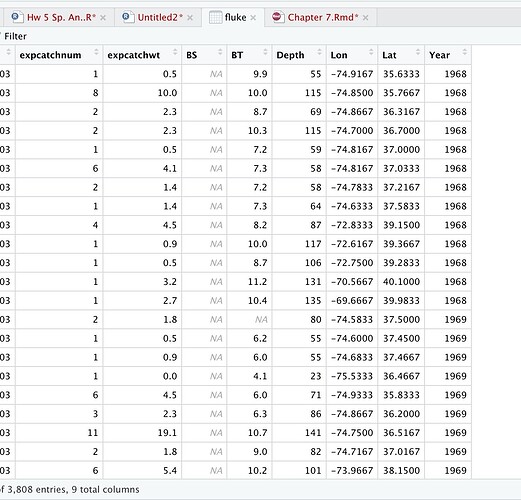I have several indices calculated for my data set (see code below). I want to calculate these indices for each year I have in my data set. (1968-2017, see screenshot). I have heard that I can use "loops" for this, however I am unfamiliar with them and haven't had luck trying them on my own. Any help is greatly appreciated.
I am particularly interested in calculating the indices based on the "expcatchnum" for each "Year". (shown in code)
# Spatial Indices
library(maps)
library(RGeostats)
library(ks)
# Analyzing the spatial distribution of fluke
# calculate spatial indices for each year for expcatchnum
library(readr)
fluke <- read_csv("~/Desktop/fluke.csv")
years <- unique(fluke$Year)
nyr <- length(years)
fyr <- min(years)
indices.tab <- matrix(nrow=nyr,ncol=7)
for (i in 1:nyr) {
#1. Calculate the calendar year
year <- i+fyr-1
indices.tab[i,1] <- year
fluke.sub <- fluke[fluke$Year==year & fluke$Lon<10,]
#2. calculate lloyd's index of patchiness (including the zeros)
nbar= mean(fluke.sub$expcatchnum)
ssq= var(fluke.sub$expcatchnum)
IoP= 1+ ssq/(nbar^2) - 1/nbar
indices.tab[i,2] <- IoP
#3. Lorenz curve
n.samp <- length(fluke.sub$expcatchnum)
n.ord <- order(fluke.sub$expcatchnum)
n.sort <- fluke.sub$expcatchnum[n.ord]
n.cum <- cumsum(n.sort)
# plot(1:n.samp,n.cum,xlab="Samples",ylab="Cumulative sum")
# title(main=year)
# lines(c(0,length(n.cum)),c(0,N.tot))
#polygon(c(1:n.samp,0),c(n.cum,0),col="gray")
#4. Calculate the Gini Index
# 4 in hw
i.vec <- c(1:(n.samp-1))
N.tot <- sum(fluke.sub$expcatchnum)
gini <- sum(i.vec*(n.samp-i.vec)*(n.sort[-1]-n.sort[1:(n.samp-1)]))/((n.samp-1)*N.tot)
indices.tab[i,3] <- gini
#5. Fit the ellipse to determine centroids
# 6 in hw
aaa<-db.create(fluke.sub[,c('Lon','Lat','expcatchnum')],flag.grid=F,ndim=2,autoname=F)
res.cgi1<-SI.cgi(aaa,flag.ellipse=T, flag.inertia=T,flag.plot=F)
indices.tab[i,4] <- res.cgi1$center[1]
indices.tab[i,5] <- res.cgi1$center[2]
indices.tab[i,6] <- res.cgi1$inertia
indices.tab[i,7] <- res.cgi1$weight
}
indices.df <- data.frame(indices.tab)
names(indices.df) <- c("Year","Lloyds","Gini","cog.lon","cog.lat","Inertia","Weight")
